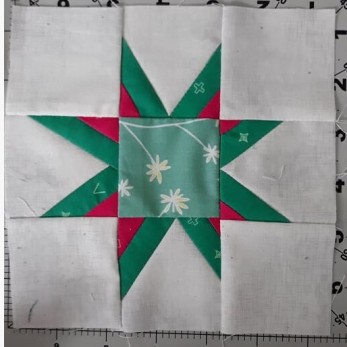Two Tone Wonky Star Tutorial – 6 “ finished
Today you are in for a treat as it is my turn on the schedule! We are going to make a variant of the wonky star. Do you have lots of little pieces of offcuts hiding in your stash bucket? These will be perfect for the star points.
If you don’t fancy doing a little star or two tone- see here for variants on the pattern including upsizing to 12” finished, using one fabric or even offsetting your stars! (These will be released over the weekend)

Materials:

- 1 x 2.5” square (centre)
- 8 x 2.5” square (background and star points)
- 16 x 1” x 3” scraps for the star points
Tip: Due to the smaller pieces involved throughout the stages when pressing between each step I would recommend finger pressing or using a seam roller to avoid distortion of the seams/fabrics. Once the block is assembled press using an iron to set the seams and ensure a smoother look.
Tip: Some of you may prefer longer or fatter stars in which case adjust the size of your strips by ¼” to ½” either in length or width.
Method
1 – Take a background 2.5” square and the rectangle piece to be the outer point of the star. Lay it right side down on top of the square on the top right side. Changing the angle of the way it is laid down will affect the wonk of the star point. As a guide I normally start it about half way across the square when you stitch. Ensure both ends of the strip extend pass the square.
Trim down to a ¼” seam then press the strip away from the background.
2 – Lay the second strip on top of the first, ensuring both ends of the strip are extending pass the square and sew along it. Press open away from the background.

3 – You are now ready to work on the second side. Take the outer point strip and like the first point lay it at an angle across the top left side of the square. The strips can overlap with the right pair at the bottom or there could be a gap- each variation affects the wonky point, just ensure the strip extends pass the square at both sides.
Sew the strip, then trim the excess fabric down to a ¼” seam. Press the strip away from the background.
Tip: If you would like your star points to be more pointy (i.e. can’t see the join of both sides, ensure that when you place the second section, the part where they overlap on the sewn line is ¼” or less from the edge of the block.
4 – Take the inner star point strip and lay it across the opened strip, ensuring it extends pass the square. Sew and press the strip away from the background.

5 – You are now ready to square up your star point! Trim the piece down to 2.5” square.
6- Repeat this 3 more times to have 4 star point squares.
7- Lay out your star points, the centre fabric and background corners in your desired layout of 3 x 3.
Sew each row separately and press seams to the side. For the top and bottom row press the seams away from the centre square (star point). Then the middle row press seams towards the centre. This will help the seams sit together (nest) for a flatter block.

Sew the rows together and as the seams on each row have been pressed to alternative sides, it is easier to line the rows up as the seams sit neatly next to each other.
Hopefully you are all still with me! And your block is now done!
Visit our designers on Instagram to see our versions of this block : @cotefleurie @getahashtagkim @JustSewSue @lisasew @metroquilter @picosailors @pippaspatch @quirkyhannah @surfseasew @therunninghare
Don’t forget to use the hashtag #scrapbagsampler on IG to show us your version or one of the variations.



























